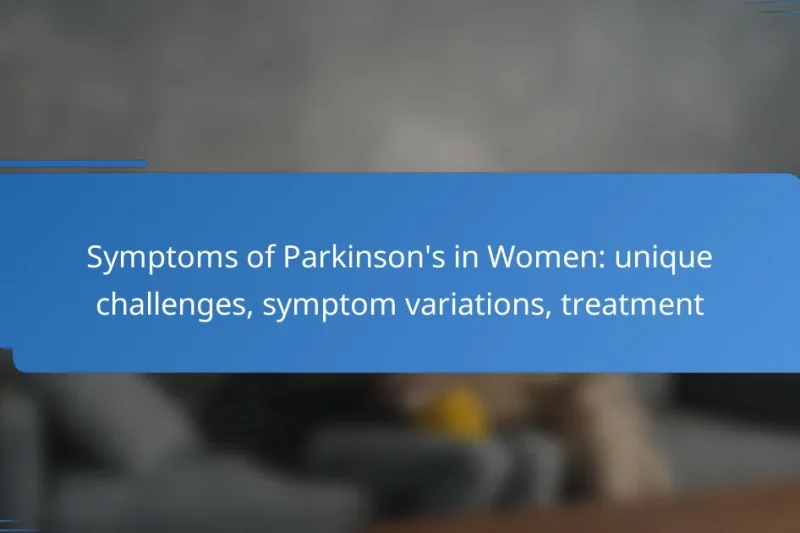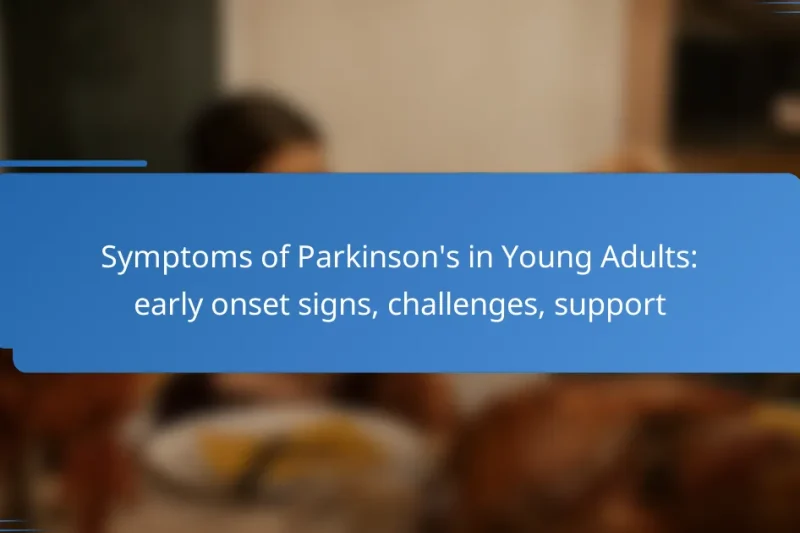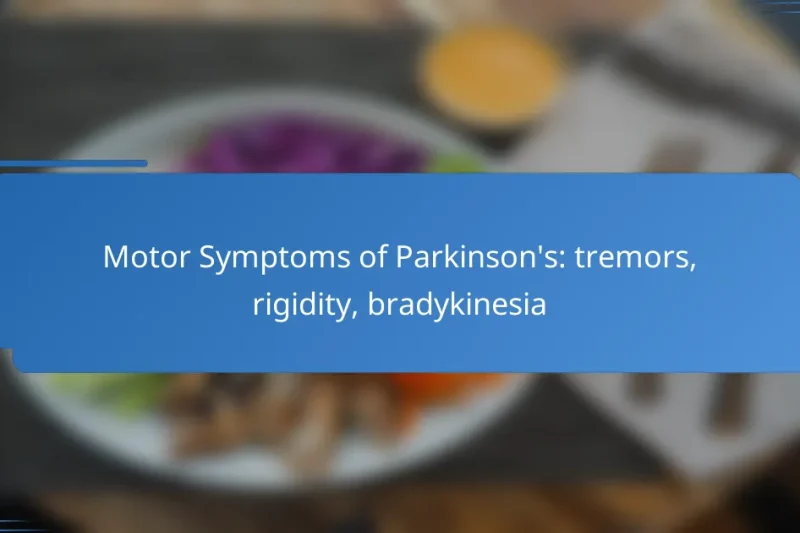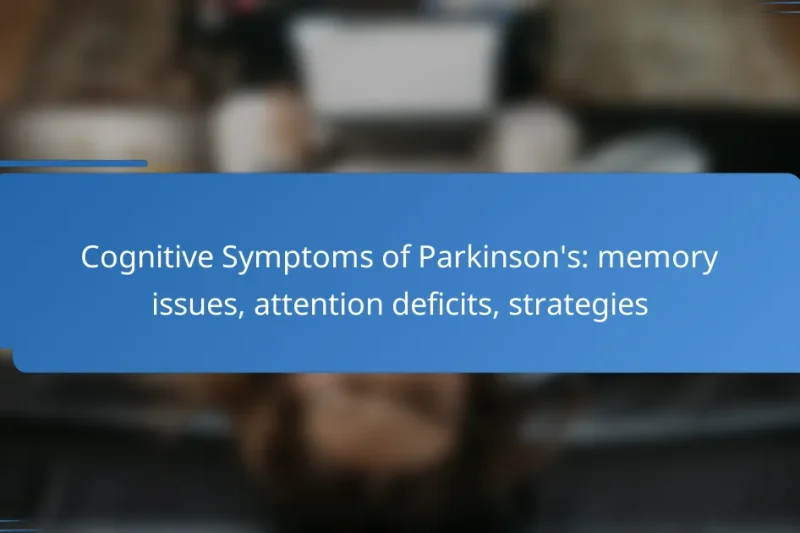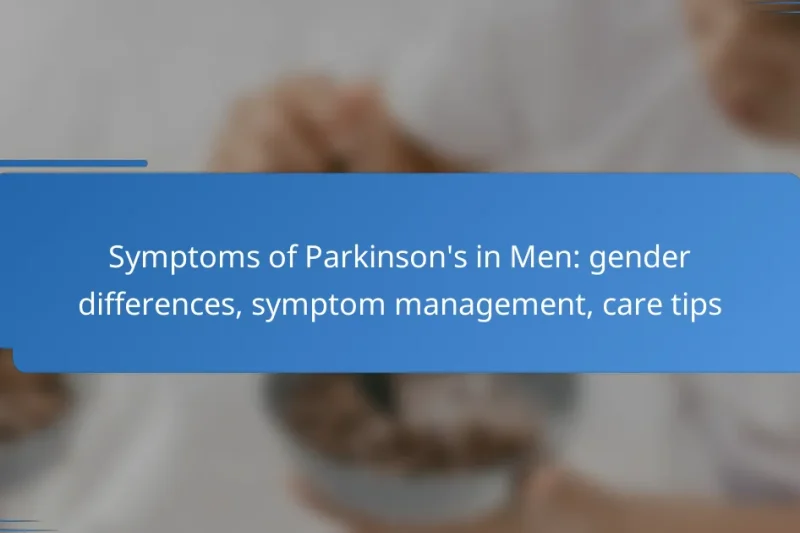Parkinson’s disease not only affects motor functions but also brings about significant psychological symptoms such as … Psychological Symptoms of Parkinson’s: anxiety, depression, coping strategiesRead more
Understanding Parkinson’s: Symptoms and Progression
Parkinson’s disease is a progressive neurological disorder that affects movement and can present with both motor and non-motor symptoms. Early recognition of these signs is crucial for timely diagnosis and effective management, ultimately enhancing the quality of life for those affected. The progression of the disease varies among individuals, influenced by factors such as age and overall health, making personalized treatment plans essential.
Parkinson’s and Speech Changes: communication difficulties, therapy options, exercises
Parkinson’s disease can lead to significant communication difficulties, affecting speech clarity, volume, and articulation, which in … Parkinson’s and Speech Changes: communication difficulties, therapy options, exercisesRead more
Symptoms of Parkinson’s in Women: unique challenges, symptom variations, treatment
Women with Parkinson’s disease face unique challenges as their symptoms often differ from those experienced by … Symptoms of Parkinson’s in Women: unique challenges, symptom variations, treatmentRead more
Symptoms of Parkinson’s in Young Adults: early onset signs, challenges, support
Parkinson’s disease can affect young adults differently than older individuals, presenting early onset symptoms such as … Symptoms of Parkinson’s in Young Adults: early onset signs, challenges, supportRead more
Symptoms of Parkinson’s in Seniors: age-related considerations, care strategies
Parkinson’s disease presents unique challenges for seniors, with common symptoms such as tremors, stiffness, and cognitive … Symptoms of Parkinson’s in Seniors: age-related considerations, care strategiesRead more
Symptoms Fluctuations in Parkinson’s: on-off phenomena, management strategies
In Parkinson’s disease, patients often experience significant fluctuations in symptoms, commonly referred to as “on-off” phenomena, … Symptoms Fluctuations in Parkinson’s: on-off phenomena, management strategiesRead more
Motor Symptoms of Parkinson’s: tremors, rigidity, bradykinesia
The motor symptoms of Parkinson’s disease, including tremors, rigidity, and bradykinesia, can profoundly affect the daily … Motor Symptoms of Parkinson’s: tremors, rigidity, bradykinesiaRead more
Cognitive Symptoms of Parkinson’s: memory issues, attention deficits, strategies
Cognitive symptoms of Parkinson’s disease, including memory issues and attention deficits, can profoundly affect an individual’s … Cognitive Symptoms of Parkinson’s: memory issues, attention deficits, strategiesRead more
Parkinson’s and Gait Disturbances: walking difficulties, safety tips, management
Parkinson’s disease often leads to gait disturbances such as shuffling, freezing, and difficulty initiating movement, which … Parkinson’s and Gait Disturbances: walking difficulties, safety tips, managementRead more
Symptoms of Parkinson’s in Men: gender differences, symptom management, care tips
Parkinson’s disease presents distinct symptoms in men, including tremors, bradykinesia, and muscle stiffness, which can significantly … Symptoms of Parkinson’s in Men: gender differences, symptom management, care tipsRead more
What are the early symptoms of Parkinson’s in New Zealand?
The early symptoms of Parkinson’s disease in New Zealand can include a range of motor and non-motor signs. Recognizing these symptoms early can lead to timely diagnosis and management, improving quality of life for those affected.
Tremors
Tremors are often one of the first noticeable symptoms of Parkinson’s disease. They typically start in one hand and can manifest as a rhythmic shaking when the hand is at rest. These tremors may become more pronounced during periods of stress or fatigue.
In New Zealand, individuals may notice that their tremors interfere with daily tasks, such as writing or holding utensils. Seeking medical advice early can help in managing these symptoms effectively.
Bradykinesia
Bradykinesia refers to the slowness of movement, which is a hallmark of Parkinson’s disease. Individuals may find it increasingly difficult to initiate movements or may notice a significant reduction in the speed of their actions.
In practical terms, this can affect daily activities such as walking, dressing, or even speaking. Patients in New Zealand should be aware that bradykinesia can lead to a decreased ability to perform tasks independently.
Muscle stiffness
Muscle stiffness, or rigidity, is another common symptom of Parkinson’s disease. This stiffness can cause discomfort and limit the range of motion in affected individuals, often leading to a feeling of tightness in the muscles.
In New Zealand, muscle stiffness may impact posture and balance, making it harder to perform physical activities. Regular exercise and physical therapy can be beneficial in managing this symptom.
Postural instability
Postural instability is characterized by difficulty maintaining balance and coordination. This symptom can increase the risk of falls, which is a significant concern for individuals with Parkinson’s disease.
In New Zealand, patients may benefit from balance training and fall prevention strategies to enhance safety and mobility. Awareness of this symptom is crucial for maintaining independence.
Changes in handwriting
Changes in handwriting, known as micrographia, often occur in the early stages of Parkinson’s disease. Individuals may notice that their handwriting becomes smaller and more cramped over time.
This symptom can be frustrating and may affect communication. In New Zealand, using larger writing tools or practicing handwriting exercises can help mitigate these changes.
How does Parkinson’s progress over time?
Parkinson’s disease typically progresses gradually, with symptoms worsening over several years. The rate of progression can vary significantly among individuals, influenced by factors such as age, overall health, and treatment adherence.
Stages of progression
Parkinson’s is often described in five stages, each characterized by specific symptoms and functional abilities. In the early stages, symptoms may be mild and barely noticeable, while later stages can lead to severe motor and non-motor challenges.
Stage 1 involves mild symptoms that do not interfere with daily activities. By Stage 2, symptoms become more pronounced, affecting both sides of the body. In Stage 3, balance issues emerge, and individuals may experience significant mobility challenges. Stages 4 and 5 indicate advanced disease, where individuals may require assistance with daily tasks and may be unable to walk unassisted.
Common complications
As Parkinson’s progresses, individuals may face various complications, including cognitive decline, depression, and sleep disturbances. These complications can significantly impact quality of life and may require additional management strategies.
Motor complications such as dyskinesia (involuntary movements) and freezing episodes can also occur, complicating mobility and daily functioning. It’s essential to monitor these symptoms closely and adjust treatment plans accordingly.
Impact on daily activities
The progression of Parkinson’s can profoundly affect daily activities, from basic self-care to social interactions. Early on, individuals may notice slight changes in their ability to perform tasks, but as the disease advances, these challenges can become more pronounced.
Common difficulties include problems with fine motor skills, such as writing or buttoning clothing, and challenges with balance and coordination. Engaging in occupational therapy can provide strategies to adapt daily activities and maintain independence for as long as possible.
What treatments are available for Parkinson’s in New Zealand?
In New Zealand, various treatments are available for managing Parkinson’s disease, focusing on alleviating symptoms and improving quality of life. These treatments include medications, physical therapy, surgical options, and support groups, each playing a vital role in a comprehensive care plan.
Medications
Medications for Parkinson’s in New Zealand primarily aim to manage symptoms, particularly motor issues like tremors and rigidity. Commonly prescribed drugs include levodopa, dopamine agonists, and MAO-B inhibitors, which help increase dopamine levels in the brain.
Patients often need to adjust their medication regimen over time, as effectiveness can change. Regular consultations with a neurologist are essential to tailor the treatment plan based on individual responses and side effects.
Physical therapy
Physical therapy is crucial for maintaining mobility and balance in individuals with Parkinson’s. Therapists design personalized exercise programs to enhance strength, flexibility, and coordination, which can help reduce falls and improve daily functioning.
In New Zealand, many physiotherapists specialize in neurological conditions, providing targeted interventions. Patients are encouraged to engage in regular physical activity, as it can significantly improve overall well-being and quality of life.
Surgical options
Surgical options, such as deep brain stimulation (DBS), are considered for patients with advanced Parkinson’s who do not respond adequately to medications. DBS involves implanting electrodes in specific brain areas to help regulate abnormal signals associated with movement.
In New Zealand, eligibility for surgery is determined through a thorough assessment by a multidisciplinary team. While surgery can provide significant symptom relief, it is essential to weigh the potential benefits against the risks and complications involved.
Support groups
Support groups play a vital role in the Parkinson’s community in New Zealand, offering emotional support and practical advice for patients and their families. These groups provide a platform for sharing experiences, coping strategies, and information about the disease.
Joining a support group can help reduce feelings of isolation and improve mental health. Many organizations, such as Parkinson’s New Zealand, facilitate local meetings and online forums, making it easier for individuals to connect with others facing similar challenges.
How can lifestyle changes help manage Parkinson’s symptoms?
Lifestyle changes can significantly alleviate Parkinson’s symptoms by promoting overall health and enhancing quality of life. Adopting a balanced diet, engaging in regular exercise, and implementing stress management techniques can help individuals manage their condition more effectively.
Dietary modifications
Dietary modifications play a crucial role in managing Parkinson’s symptoms. A balanced diet rich in fruits, vegetables, whole grains, and lean proteins can support brain health and overall well-being. Foods high in antioxidants, such as berries and leafy greens, may help reduce oxidative stress.
Consider incorporating omega-3 fatty acids found in fish like salmon or walnuts, as they may have neuroprotective effects. Staying hydrated is also essential; aim for at least 8 cups of water daily, adjusting based on activity levels and climate.
Exercise routines
Regular exercise is vital for managing Parkinson’s symptoms, as it can improve mobility, balance, and strength. Aim for at least 150 minutes of moderate aerobic activity each week, such as walking, swimming, or cycling. Strength training exercises should be included at least twice a week.
Activities like yoga and tai chi can enhance flexibility and reduce stress. It’s important to choose exercises that are enjoyable and sustainable, as consistency is key to reaping the benefits.
Stress management techniques
Effective stress management techniques can help mitigate the emotional and physical symptoms of Parkinson’s. Mindfulness practices, such as meditation and deep-breathing exercises, can promote relaxation and improve mental clarity. Aim to practice these techniques for at least 10-15 minutes daily.
Engaging in hobbies, spending time with loved ones, and participating in support groups can also alleviate stress. Consider setting aside time each week for activities that bring joy and fulfillment, as this can enhance overall emotional health.
What are the differences between Parkinson’s and other movement disorders?
Parkinson’s disease is distinct from other movement disorders due to its specific symptoms and underlying mechanisms. While it shares some characteristics with other conditions, key differences in symptom presentation and progression help in diagnosis and treatment.
Parkinson’s vs. Essential tremor
Parkinson’s disease and essential tremor are both movement disorders, but they differ primarily in the nature of the tremors. Essential tremor typically presents as a rhythmic shaking, especially in the hands during movement, while Parkinson’s tremors are often more pronounced at rest and may involve a characteristic “pill-rolling” motion of the fingers.
Another distinction is that essential tremor generally does not lead to significant rigidity or bradykinesia (slowness of movement), which are hallmark symptoms of Parkinson’s. Patients with essential tremor may respond well to beta-blockers or anti-seizure medications, whereas Parkinson’s treatment often involves dopaminergic medications.
Parkinson’s vs. Multiple system atrophy
Multiple system atrophy (MSA) is a rare neurodegenerative disorder that shares some symptoms with Parkinson’s, such as stiffness and balance issues. However, MSA typically progresses more rapidly and can lead to severe autonomic dysfunction, affecting blood pressure and bladder control, which are not common in Parkinson’s.
Patients with MSA may also experience more pronounced problems with coordination and speech earlier in the disease course. Diagnosis can be challenging, but distinguishing features like the presence of severe postural instability and early falls can help differentiate MSA from Parkinson’s disease.
What resources are available for Parkinson’s patients in New Zealand?
Parkinson’s patients in New Zealand have access to various resources that provide support, information, and services tailored to their needs. These resources include local organizations, health services, and community programs aimed at improving the quality of life for those affected by Parkinson’s disease.
Local support organizations
Several local support organizations in New Zealand focus on assisting Parkinson’s patients and their families. The Parkinson’s New Zealand organization offers a range of services, including support groups, educational resources, and advocacy for patients and caregivers.
Additionally, many regional branches provide tailored support, such as exercise programs and social activities that foster community connections. These initiatives help patients manage their symptoms and maintain a sense of normalcy in their daily lives.
Patients can also access resources like helplines and online forums, which offer immediate assistance and a platform for sharing experiences with others facing similar challenges. Engaging with these local support organizations can significantly enhance the overall well-being of individuals living with Parkinson’s disease.


